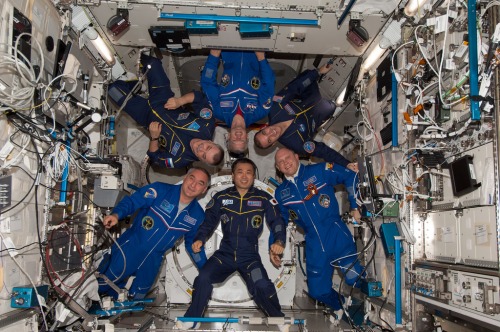
(Photo credit: NASA)
It seems that even at 260 miles above the Earth, you can not escape politics.
The International Space Station is a successful space endeavour which has been achieved through the continued cooperation of the American and Russian space agencies. The station has been successfully orbiting the Earth since 1998 and has been constantly manned for 13 years, however a series of political gestures are now threatening the future of the station. Following Russia’s annexation of the Crimean Peninsula, the tension has been rising between America and Russia. Some are even calling this turbulent time the worst East-West crisis since the 1991 collapse of the Soviet Union.
The American government began imposing visa bans and asset freezes on Russian officials and lawmakers. The United States then prevented their federal officials meeting with their Russian counterparts and they prohibited technology exports to Russia. Similarly, they placed limitations on companies who had known links to Russian President Vladimir Putin. NASA also announced that it was forced to cease almost all cooperation with the Russian Space Agency, Roscosmos, in protest against Russia’s actions. However NASA did acknowledge that contact between the agencies would have to occur in order to maintain successful operations onboard the International Space Station.
Deputy Prime Minister Dmitry Rogozin responded by stating that Moscow would prevent Washington from using Russian-made rocket engines if they’re used to launch American military hardware. Russia will also shut down monitoring stations on its soil that support services based on American Global Positioning System (GPS). But the most devastating announcement came when Russia threatened not to extend it’s space station operations beyond 2020.
This is a massive blow to space agencies around the world as Washington recently confirmed that it wishes to keep the space station in use until at least 2024. Russia’s deputy Prime Minister, Dmitry Rogozin, declared that Moscow was planning “strategic changes” in its space industry. He suggested Russia can operate the station without the United States segments, even hinting at the prospect of dissolution of the International Space Station. Rogozin said “The Russian segment can exist independently from the American one. The U.S. one cannot”
Since its birth, the International Space Station has been a symbol of peace and cooperation between the two countries. The station has been a shining example of the post-Cold War cooperation that occurred between America and Russia as the station has hosted astronauts and cosmonauts who have lived and worked together. But these latest comments from Russia cast doubt on the long-term future of the International Space Station.
With the retirement of the American Space Shuttle program in 2011, NASA relies on Russian Soyuz spacecraft to transport astronauts to the space station. However, the Russian Space Agency is also dependent on NASA. With international space agencies forced to pay Russia $60 million to transport each astronaut, Roscosmos is reliant on the money that NASA provides.
But, this is not the only reason why the Russian Space Agency depends upon America. The ISS is arguably the most expensive single item ever constructed as its cost is estimated to be over $150 billion yet NASA currently provides the majority of its funding. Around 81% derives from USA as NASA spends $58.7 billion each year on the station, while Russia only contributes $12 billion. Therefore without NASA providing finances towards the ISS, Roscosmos would find it incredibly difficult to operate.
Dmitry Rogozin, the Deputy Russian Prime Minister recently commented “After analysing the sanctions against our space industry I suggest the US delivers its astronauts to the ISS with a trampoline”. He even posted a picture of trampoline with a NASA badge.
With these threats, discussions are being held in the US Congress about whether more money should be made available to help replace the Roscosmos technology. But with the private space industry sector already booming, companies such as SpaceX feel ready to substitute Russian rockets and the Soyuz crew spacecraft with their own American vehicles. NASA is working closely with these companies in the hopes that they can permanently restore U.S. transport to the station by 2017
Not everyone is being so negative about the situation though. A number of astronauts have spoken out about the latest issues between NASA and Roscosmos. Steve Swanson, who is currently acting as commander of the International Space Station offered his thoughts on living alone with two Russian crewmates during this turbulent political time. When asked about the mood among his crewmates he stated “right now, we have no change up here on the way we do our operations. I’m still good friends with my Russian colleagues”.
Rick Mastracchio, a NASA astronaut, who has recently returned to Earth after inhabiting the station with Russian cosmonauts declared “all my crewmates were great. We got along fantastic. I always tell folks, even though we had astronauts from Japan and the United States and cosmonauts from Russia, I don’t look at those crewmates as being from Russia or Japan or from different places, I just look at them as my friends and my crewmates. And in any endeavour, I think that’s a great way to think about folks just as friends and as people”.

(NASA astronaut: Rick Mastracchio. JAXA astronaut: Koichi Wakata. Roscosmos cosmonauts: Alexander Skvortsov, Oleg Artemyev & Mikhail Tyurin – Photo credit: NASA)
This was first published on The Global Panorama website. I am reproducing it after taking permission to do so.
Everyone on Earth should be hoping that cooler heads will prevail in all the world’s capitals. The ISS is important for advancing scientific knowledge, both in space and back here at home.